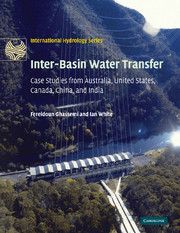Book contents
- Frontmatter
- Contents
- Foreword
- Overview and Scope
- Acknowledgements
- List of Abbreviations
- Part I The Challenges
- Part II Inter-basin Water Transfer in Australia
- Part III Inter-basin Water Transfer in Other Selected Countries
- 11 Inter-basin water transfer in the United States of America
- 12 Inter-basin water transfer in Canada
- 13 Inter-basin water transfer in China
- 14 India: The National River-Linking Project
- 15 Inter-basin water transfer, successes, failures and the future
- Part IV Appendices
- Glossary
- Index
- References
13 - Inter-basin water transfer in China
Published online by Cambridge University Press: 05 November 2009
- Frontmatter
- Contents
- Foreword
- Overview and Scope
- Acknowledgements
- List of Abbreviations
- Part I The Challenges
- Part II Inter-basin Water Transfer in Australia
- Part III Inter-basin Water Transfer in Other Selected Countries
- 11 Inter-basin water transfer in the United States of America
- 12 Inter-basin water transfer in Canada
- 13 Inter-basin water transfer in China
- 14 India: The National River-Linking Project
- 15 Inter-basin water transfer, successes, failures and the future
- Part IV Appendices
- Glossary
- Index
- References
Summary
OVERVIEW OF GEOGRAPHY, POPULATION, LAND AND WATER
GEOGRAPHY
The People's Republic of China (PRC) was established in 1949. Its mainland covers an area of 9 560 980 km2 and has a varied topography with highlands in the west and plains in the east. This physical feature of gradual descent from the west to the east causes all the major rivers to run eastwards. China has the following physiographic features (China Handbook Editorial Committee, 2002):
Mountain ranges run in different directions across the length and breadth of the country (Figure 13.1). These are: (1) the west–east ranges consisting of the Tianshan, Yanshan, Kunlun, Qinling and Nanling Mountains; (2) the north-east to south-west ranges consisting of the Greater Hinggan, Taihang, Changbai, Wuyi and Taiwan Mountains; (3) the north-west to south-east ranges consisting of the Qilian and Altai Mountains; and (4) the north–south ranges consisting of the Helan, Liupan and Hengduan Mountains. The Himalayas lie on the south-western border of China and run in a west–east direction. Of the world's 14 mountain peaks exceeding 8000 m, nine are in China or on its borders.
[…]
- Type
- Chapter
- Information
- Inter-Basin Water TransferCase Studies from Australia, United States, Canada, China and India, pp. 295 - 318Publisher: Cambridge University PressPrint publication year: 2007

